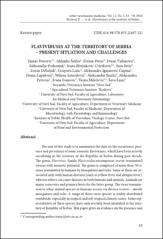| dc.contributor.author | Petrović, Tamaš | |
| dc.contributor.author | Šekler, Milanko | |
| dc.contributor.author | Petrić, Dušan | |
| dc.contributor.author | Vidanović, Dejan | |
| dc.contributor.author | Potkonjak, Aleksandar | |
| dc.contributor.author | Hrnjaković Cvjetković, Ivana | |
| dc.contributor.author | Savić, Sara | |
| dc.contributor.author | Debeljak, Zoran | |
| dc.contributor.author | Lazić, Gospava | |
| dc.contributor.author | Ignjatović Ćupina, Aleksandra | |
| dc.contributor.author | Lupulović, Diana | |
| dc.contributor.author | Samojlović, Milena | |
| dc.contributor.author | Jurišić, Aleksandar | |
| dc.contributor.author | Petrović, Aleksandra | |
| dc.contributor.author | Ivanović, Ivana | |
| dc.contributor.author | Milošević, Vesna | |
| dc.contributor.author | Lazić, Sava | |
| dc.date.accessioned | 2019-11-06T11:41:08Z | |
| dc.date.available | 2019-11-06T11:41:08Z | |
| dc.date.issued | 2018 | |
| dc.identifier.issn | 1820-9955 | |
| dc.identifier.uri | https://repo.niv.ns.ac.rs/xmlui/handle/123456789/138 | |
| dc.description.abstract | The aim of this study is to summarize the data on the occurrence, presence and prevalence of some zoonotic flaviviruses, which have been actively circulating in the territory of the Republic of Serbia during past decade. The genus Flavivirus, family Flaviviridae,encompasses vector-transmitted viruses with zoonotic potential. The genus is comprised of more than 70 viruses transmitted to humans by mosquitoes and ticks. Some of those are associated only with human diseases (such as yellow fever and dengue fever), whereas others can cause diseases in both humans and animals. Animals are major reservoirs and primary hosts for the latter group. The virus transmission to other animal species or humans occurs via diverse vectors – mostly mosquitoes and ticks. A range of these virus species is widely distributed worldwide, especially in tropical and sub-tropical climatic zones. Some representatives of these species have only recently been identified at the territory of Republic of Serbia. This paper gives an evidence on the presence and distribution of West-Nile virus, tick-borne encephalitis (TBE) virus and
Usutu virus that were conducted within the study in Serbia. The research pointed out the presence of recently detected West-Nile virus and Usutu virus as well as the current circulation of tick-borne encephalitis virus, for which only limited serological evidence on the presence of virus-specific antibodies in humans was available so far. In the aspect of public health, the full understanding of the importance of identification and prevalence of different flaviviruses still require further comprehensive entomologicalacarological, seroepidemiological, clinical and virological research. | en_US |
| dc.description.sponsorship | This work was produced within the framework of Project TR31084 funded by the Ministry of Education, Science and Technological Development of Republic of Serbia. | en_US |
| dc.language.iso | en | en_US |
| dc.publisher | Naučni institut za veterinarstvo "Novi Sad" | en_US |
| dc.source | Arhiv veterinarske medicine / Archives of veterinary medicine | sr |
| dc.subject | flaviviruses | en_US |
| dc.subject | West-Nile virus | en_US |
| dc.subject | tick-borne encephalitis virus | en_US |
| dc.subject | Usutu virus | en_US |
| dc.subject | Serbia | en_US |
| dc.title | Flaviviruses at the territory of Serbia - present situation and challenges | en_US |
| dc.title.alternative | Flavivirusi na području Srbije - trenutno stanje i izazovi | en_US |
| dc.type | Article | en_US |
| dc.identifier.doi | 10.46784/e-avm.v11i2.26 | |
| dc.identifier.doi | | |

